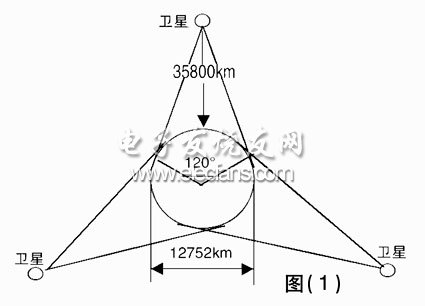The radio and television industry is one of the fastest-growing businesses in many of China's undertakings. Among them, high-tech content is also an industry with high gold content in various industries. As a worker engaged in satellite communications in the communications industry, I am honored to be a role in the contemporary society in which our television industry is thriving. At the same time, many people are very concerned about some of the technologies, but they are not very familiar with them. The author wants to briefly explain some core technologies of satellite digital TV and the DVB-S standard from the basic concepts. This article refers to the address: http:// Basic principles of satellite communication Satellites can be divided into: resource detection satellites, meteorological satellites, military satellites, communication satellites, and direct broadcast satellites. In theory, global communication or global broadcasting can be achieved if three satellites spaced 120 degrees apart are placed over the Earth's equator relative to the geostationary satellite orbit. Figure 1): Satellite TV transmission was developed on the basis of satellite communication. It is a technology that directly transmits large-area broadcast television coverage on the geostationary satellite at 35800km above the Earth's equator, carrying transponders and antenna systems to forward broadcast television signals to the ground. . It can cover a wide range of users in the area to watch TV programs directly on the other side of the globe and even on the other side of the globe. China has a vast territory, complex terrain, large population, and uneven distribution. It is extremely difficult to completely rely on traditional terrestrial wireless transmission to solve radio and television coverage. The use of satellite transmission of radio and television programs, as the most effective, economical and advanced means to improve the coverage of radio and television, improve the transmission quality, has been vigorously developed and widely used in the past decade. DVB introduction The DVB organization is an international organization with 230 organizations from 33 countries. The General Administration of Radio, Film and Television of the State Administration of Radio, Film and Television joined the DVB organization on April 13, 1999 as a member of the association. At the same time, DVB (Digital Video Broadcasting) is also the European digital video broadcasting standard. The main standards include satellite TV DVB-S, cable TV DVB-C, terrestrial broadcast ordinary TV DVB-T and high definition television (HDTV) broadcast and Transmission, the above three transmission standards are numbered ETS300421, ETS300429 and ETS300744ETS are European telecommunications standards. DVB-S is a set of digital broadcasting technology specifications for changing the analog TV technology due to different standards. It is responsible for promoting its international standard of digital broadcasting technology and promoting the international exchange and cooperation of radio and television technology. The task of development. The main goal of the DVB project is to find a digital TV technology and system that is suitable for all transmission media. The requirements for it are: 1. Flexible transmission of MPEG-2 video, audio and other data signals. 2. Use a unified MPEG-2 transport bitstream multiplexing. 3. Use the unified service information system to provide details such as the details of the broadcast program. 4. Use a unified Tier-Solomon forward error correction system. 5. Use a unified scrambling system, but there are different encryption methods. 6. Select the modulation scheme and channel coding method applicable to different transmission media and any necessary additional error correction methods. 7. Encourage the use of the DVB standard outside Europe to promote the establishment of worldwide digital video broadcasting standards. 8. Support teletext systems in digital systems. The core technology of DVB-S system The core technology of the DVB system is universal MPEG-2 video and audio coding. Currently, it is mainly used in digital satellite and television broadcasting, MP@ML. The first generation of European DVB receivers will provide up to 625 lines of studio quality ITU-Rec, BT601? images? ITU is ITU? It can be 4:3 or 16:9 aspect ratio. The code rate used can also be determined according to business requirements. In general, the higher the selected code rate, the better the quality of the image, but the wider the occupied frequency band. The choice of the code rate has a great relationship with the content of the image. For images with more motion, such as sports programs, a higher code rate can be used, and for programs such as cartoons, a lower code rate can be used. Therefore, in the case of combining a plurality of program bit streams into one bit stream, statistical multiplexing is used, and the total code rate can be flexibly allocated between programs of different code rates. In order to meet the requirements of various materials, ITU-Rec, BT601 studio quality required digital is 9Mbit / s, PAL / SECAM, broadcast quality required digital rate of 5Mbit / s, because the use of MPEG-2 transmission bit stream is a The data packet structure, so it is convenient to add appropriate information, put together various services, such as image, sound and data services, and specify the format of the service information. The standard formed is the service information. Standard ETS300468. The DVB system uses the low data rate MPEG-1 Layer II audio standard as its universal audio compression coding standard to obtain sound close to CD quality. The standard for DVB-S systems describes the frame structure, channel coding and modulation scheme used for satellite digital multiplex transmission. The organization flow and block diagram of the uplink signal in the satellite transmission system are as follows: Multi-core PVC Electrical Cable Multi-Core PVC Electrical Cable,Multicore PVC Cable,Multicore PVC Wire,Multicore Power Cable Shenzhen Hongyan Wire Industry Co., Ltd. , https://www.hy-cable.com
